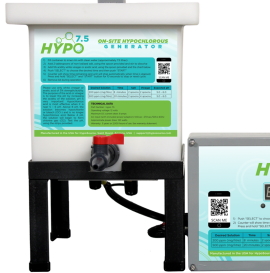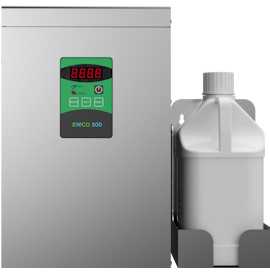Research > Microbe > Viruses > Hepatitis B
Common Names for Hypochlorous Acid Solutions
- Electrolytically Generated Hypochlorous Acid
- Neutral Electrolyzed Water (NEW)
- Electrolyzed Oxidizing Water (EOW)
- Electro-chemically Activated Water (ECA)
- Super-oxidized water (SOW)
Results: 3 published articles

Microbe(s): Total Microbial Count, Hepatitis B Virus
Background and Aim: Two percent glutaraldehyde, the most widely used liquid chemical germicide (LCG), may be hazardous to patients and medical personnel. Alternatives to glutaraldehyde, such as electrolyzed acid water (EAW), are being developed, but data from well-controlled studies with patient-used endoscopes are rare. The purpose of the present paper was to evaluate the high-level disinfection capability of EAW and compare it with glutaraldehyde. Methods: A random sample of 125 endoscopes was collected immediately after upper endoscopic examination. After careful manual cleaning, endoscopes were divided into a glutaraldehyde and EAW group. After the disinfection procedure, samples from working channel (S-1), insertion tube (S-2), umbilical cord (S-3), and angulation knob (S-4) were taken and cultured. Another twenty endoscopes were experimentally contaminated with hepatitis B virus (HBV) and samples were collected after contamination (T-1), after manual cleaning (T-2), and after final disinfection (T-3). Polymerase chain reaction (PCR) for HBV-DNA was performed. Results: In the EAW group, culture-positive rates were 3.2% in S-1, 9.5% in S-2, 3.2% in S-3, and 27.0% in the S-4 samples. There was no significant difference between the EAW and glutaraldehyde groups for all sampling sites. However, in both groups, disinfection of the angulation knobs (S-4) was less efficient than the others. For the T-1 site, HBV-DNA was detected from all of them, and in 95% (19/20) of T-2. However, HBV-DNA was not detected from T-3 samples. Conclusions: Electrolyzed acid water is as efficient as glutaraldehyde in eliminating bacteria from patient-used endoscopes. After disinfection procedures using both methods, HBV-DNA was not detected from any endoscopes experimentally contaminated with HBV-positive mixed sera. However, some bacteria may remain on the surface of the endoscopes. Therefore, more careful precleaning of the endoscopes may help achieve high-level disinfection in the clinical setting.

Microbe(s): Hepatitis B Virus, Hepatitis C Virus
Background: It is well known that strongly acidic electrolyzed water (SAEW) has a potent bactericidal effect. We examined residual viruses on endoscopes that were used in hepatitis B virus (HBV)-positive and hepatitis C virus (HCV)-positive patients and evaluated the effectiveness of SAEW in cleaning/disinfecting the endoscopes. Methods: A random sample of endoscopes used in 109 endoscopies on HBV-positive patients and 107 endoscopies on HCV-positive patients, who underwent upper gastrointestinal endoscopy for various reasons was taken to determine the degree of HBV and HCV contamination. Samples were taken using 10 mL of physiological saline injected through the forceps channel of each endoscope and collected at the distal end to be assayed using polymerase chain reaction (PCR). After examination, each endoscope was treated with air aspiration, then 200 mL of tap water that contained an enzyme detergent was absorbed, and SAEW was aspirated after cleaning with a brush. After each procedure, PCR was used for comparison and to identify any residual viruses. Results: In saline collected after air aspiration, viruses were detected in 39/109 endoscopes used in HBV patients and in 20/107 endoscopes used in HCV patients. In the saline aspirated with tap water containing an enzyme detergent, HBV was detected in 12/109 endoscopes and HCV was detected in 6/107 endoscopes. However, neither HBV nor HCV was detected after the endoscopes were cleaned manually with a brush and disinfected with SAEW. Conclusion: Endoscopes contaminated with HBV and HCV are effectively cleaned and disinfected by SAEW.

Microbe(s): Viruses, Hepatitis B Virus, HIV
Electrolyzed products of sodium chloride solution were examined for their disinfection potential against hepatitis B virus (HBV) and human immunodeficiency virus (HIV) in vitro. Electrolysis of 0.05% NaCl in tap water was carried out for 45 min at room temperature using a 3 A electric current in separate wells installed with positive and negative electrodes. The electrolyzed products were obtained from the positive well. The oxidation reduction potential (ORP), pH and free chlorine content of the product were 1053 mV, pH 2.34 and 4.20 ppm, respectively. The products modified the antigenicity of the surface protein of HBV as well as the infectivity of HIV in time- and concentration-dependent manner. Although the inactivating potential was decreased by the addition of contaminating protein, recycling of the product or continuous addition of fresh product may restore the complete disinfection against bloodborne pathogens.
Best Hypochlorous Acid (HOCL) Generators
 Portable Hypochlorous Acid (HOCL) Machine
Portable Hypochlorous Acid (HOCL) Machine
Make high quality hypochlorous acid in the home or office.
$159.99 + Free Shipping
 HOCL Machine + Electrostatic Sprayer
HOCL Machine + Electrostatic Sprayer
Make hypochlorous acid and spray with an electrostatic cold fogger.
$309.98 + Free Shipping


